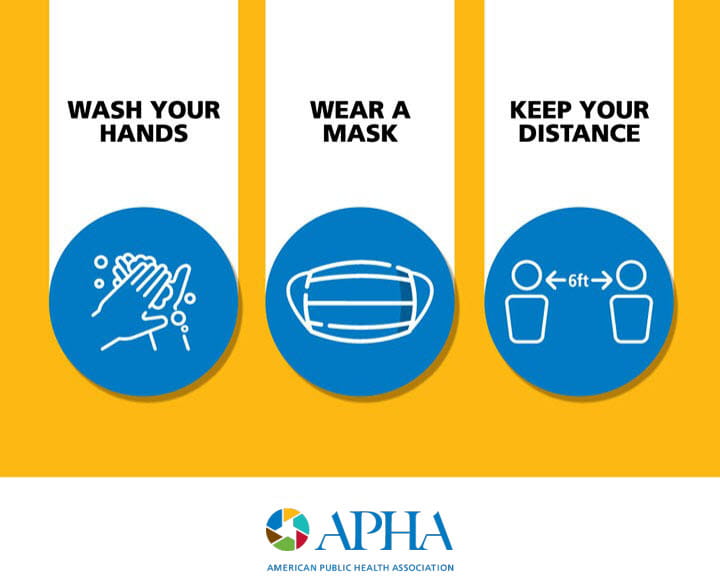As October 15 is Global Handwashing Day, I wanted to take this opportunity to remind all of you about some simple public health measures that protect not just you, not just your family, but also your friends, your colleagues, strangers you encounter in the grocery store or in the line to vote. We have all been hearing about these simple measures for years but much more regularly and from many different sources since March when the World Health Organization (WHO) officially declared COVID-19 a pandemic.
What are these steps, and why do they help protect us against COVID-19, the flu, the cold, or a myriad of other easily communicable diseases? Here you go. Are you ready?
- Wash your hands.
- Wear a mask.
- Stay physically distant.
Yes, these three steps can truly be lifesavers.
We have all seen the data. As of early October, almost 38 million cases of COVID-19 worldwide and 1.1 million people have died. In the U.S., there are 7.8 million confirmed cases, and 216,000 have died. These numbers are horrific and just seven months ago were inconceivable. But we also know, if countries around the world had not taken this threat seriously and implemented the three simple public health measures, the number of cases and people who died could have been much worse.
So how do these simple steps have such a big impact? Let’s start with handwashing. Washing your hands with water and soap can help prevent the spread of hundreds of diseases, including COVID-19. In fact, the United Nations says handwashing is the most effective and inexpensive way to prevent diarrheal and respiratory infections that take the lives of millions of children around the world every year.
One of the most common ways to pick up germs is by touching something contaminated and then touching your nose, mouth, or eyes. You can also spread germs to others by touching objects or people with your hands. So washing your hands with soap for 20 seconds, especially after using the toilet, changing a diaper, or before handling food, helps break down the grit and dirt that carry the coronavirus. But the truth is you can’t do it enough – remember warm water, soap, rub your hands together to make sure you clean every part and rinse. Sing whatever song you want for 20 seconds. I like the chorus of “One Day More” from Les Miserable, but many people sing “Happy Birthday” twice. If soap and water are not available, a hand sanitizer with at least 60% alcohol is the next best thing.
Since the COVID-19 pandemic is far from over, we must make daily decisions that reduce the virus’ spread, and the next public health intervention to talk about is one of the easiest – wear a mask.
When you’re in a public setting or around people not in your household, wear a mask. Both the U.S. Centers for Disease Control and Prevention (CDC) and WHO recommend that people wear masks to prevent COVID-19 from spreading to others. According to researchers, if 95% of people wear cloth masks, this can reduce transmission by at least 30%. That’s a big start.
There are many different mask styles and designs. I am partial to my sparkly Chicago Cubs mask. But there is only one way to wear a mask: make sure your mouth and nose are covered, wear it snugly and secured under your chin, do not fiddle with the mask while you are out, and use the ear loops or ties when you are ready to take it off.
And don’t take off your mask around other people, which brings us to the concept of maintaining physical distance. Physical distancing builds on the concept of social distancing, so the goal is to stay home as much as possible, but if you do have to go out, you should stay at least 6 feet away from others and out of crowded situations. Think about keeping a distance similar to the width of a car between you and strangers around you.
And speaking of cars, it is best not to be indoors in a place with people other than your family or the pod of the willing you have created. At the same time, you are keeping your physical distance, find ways to connect socially. As we head into winter and physically distanced walks with friends and neighbors might be harder to continue, you want to make sure you are maintaining your mental health by still finding ways to socialize and engage with your friends and loved ones.
And while I’ve got your attention, get a flu shot. You might think that if you are taking all the other steps, why should you get a flu shot since don’t they help reduce your likelihood of contracting the flu? The answer is yes, but nothing is foolproof, and we know that during the 2018-2019 U.S. flu season — the last one before COVID-19 hit — more than 35 million people got sick with the flu, more than 490,000 were hospitalized, and over 34,000 people died from influenza. COVID-19 complicates matters more, with its ability to overlap with influenza and other respiratory infections, which could result in life-threatening conditions. Even if we see a fraction of this number of cases, the impact on an already overburdened healthcare system is immeasurable.
So, wash your hands, wear a mask, maintain physical distance, and get a flu shot. Fifteen simple words that can save your life.
